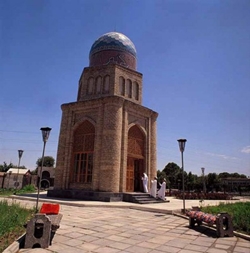 Namangan is the second largest city in Uzbekistan, one of the glorious cities of Ferghana Valley. It is located in the northern part to 200 kilometers from Tashkent city. Namangan is situated at an altitude of 476 meters above a sea level and is used to be the administrative center of the Namangan region. This city has a population of 450 thousand inhabitants.
Namangan is the second largest city in Uzbekistan, one of the glorious cities of Ferghana Valley. It is located in the northern part to 200 kilometers from Tashkent city. Namangan is situated at an altitude of 476 meters above a sea level and is used to be the administrative center of the Namangan region. This city has a population of 450 thousand inhabitants.
The first information about Namangan refers to the end of the XIV century. It is known that the settlement was established on the border of the Ferghana Valley, where nomadic herders and farmers lived.
Officially the city’s history began in 1610 year, when a city was found at the place of settlement named «Namak-kan», which is translated from Tajik and means «salt pit». It was located next to a large lake where salt was mined near the stone bridge over Namangansay.
The main reason for the development of the ancient city was the strongest earthquake in 1620 year. It was the time when, after a disaster strikes the capital of the Ferghana valley — the city of Ahsikent, located 20 kilometers from Namangan, was totally destroyed. The surviving residents moved into the newly formed city, and after a while it was no longer an unimportant town, but «Mousy-i-Namangan», It was a city which had an impact on the surrounding areas.
Thus, the fates decreed, Namangan became the successor of the legendary Aksikent. The city developed rapidly, the names of famous people who lived there tell about its status. There were a great number of well-known philosophers, scientists and poets of the East, such as: Lutfulloh, Firdausi, Babur and Mashrab.
At the beginning of the XVIII century Namangan became the part of Kokand Khanate.
Huge milestone in the development of Namangan and its agricultural surroundings was the construction of Yangiaryk channel in 1818-1821 years. Through extortion and cruel exploitation of free labor, the channel was created within three years, and after that it was deepened and expanded over the next ten years. At this time, the rise for urban artisans comes, a trade with China, Bukhara and the surrounding tribes of nomads flourishes. Sericulture, agriculture and horticulture are also up to the next level.
And yet, the years when Namangan was part of the Kokand Khanate, were not the best in its history. Endless internecine wars of the rulers undermined the economy led to the impoverishment of the population. In July of 1875 year a popular revolution broke out against the last of the Kokand ruler named Hudoyarkhan. Fled to Tashkent, under the protection of Russian arms, Hudoyarkhan provoked a military expedition of the Russian army deep into the Kokand Khanate up to Namangan town. In 1876 year, the Kokand Khanate was liquidated and Namangan became the administrative center for five county areas.
After joining Russia Namangan city within a short time became a major industrial center of Turkestan. Developing the processing industry, a great number of factories and plants revealed, a significant increase of bank capital was also planned. After connecting Namangan by train line with Kokand city, its population has increased markedly.
With the independence of the Republic of Uzbekistan, a lot has changed in the city and surrounding areas led by it. These days it is a dynamically developing industrial region. The major economic sectors are: silk, cotton processing, wine making and chemical industry. Tourist industry and handicrafts are thriving too.
Since time immemorial, Namangan has very strong religious traditions. Therefore, nowadays it can be confidently called as the center of Islam in the CIS.
